Winter running tips for dogs (and their humans)
This post includes all of my tips for winter running with dogs. I grew up in Minnesota, and I spent 12 years in North Dakota where I owned a dog walking business. Let’s just say I’m used to cold weather!
I took dogs on running sessions in all weather through my business. Sometimes it was -20 degrees Fahrenheit, and we still ran. No big deal. Just another day! Over the years, I covered more than 5,000 miles with dogs at my side.
And so, this post includes my tips for running with a dog in the winter. I’ll start by listing some of the most common questions I receive about winter running with dogs.
This post may contain affiliate links. That Mutt may earn money from the companies mentioned in this post.

When is it too cold to run with a dog? Winter running with dogs
For the most part, runners are a tough bunch. They aren’t scared off by the cold. Some runners are up before dawn, running 8 or 10 miles before work. But I still get this question – When is it too cold for a dog?
That is a tough question. What do you mean by “too cold”?
(Here I am in my creeper face mask before we all had to wear masks.)
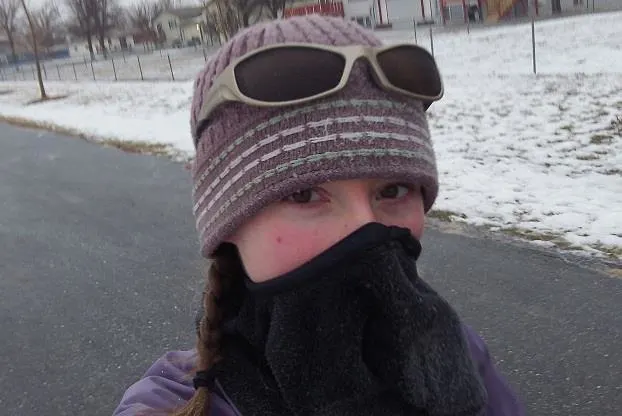
If you mean the current temperature is 20 degrees Fahrenheit and you’re wondering if your dog might get a little chilly, he’ll probably be fine as long as you’re going out for an hour or less.
I didn’t even bother to put coats on the dogs in Fargo unless it was below 10 degrees F or so. Anything above that in January was a heatwave!
Can my dog run if it’s below 10 degrees?
This depends on the dog (and the human). Obviously Midwestern dogs have adapted to the cold just like their owners have adapted. When it doesn’t get above zero for 10 days at at a time, you just kind of deal with it.
On the other hand, 10 degrees is going to feel very cold for dogs in other parts of the country, just as it will feel cold to their humans.
What I learned from years of running in the cold is that as long as you keep running (vs. walking), nearly all dogs are fine for a 30-minute run even when it gets down to 10 degrees or so.
I definitely ran with dogs when it was colder than that, but once it dips below 10 degrees I start looking at the individual dog in front of me. You also don’t want to be out for more than 20 or 30 minutes in the extreme cold, but a quick run around the block is fine.
In Montana, we even have a winter half marathon for dogs and many dogs still race if it’s one of those brutally cold days. Check out the Snow Joke Half Marathon!
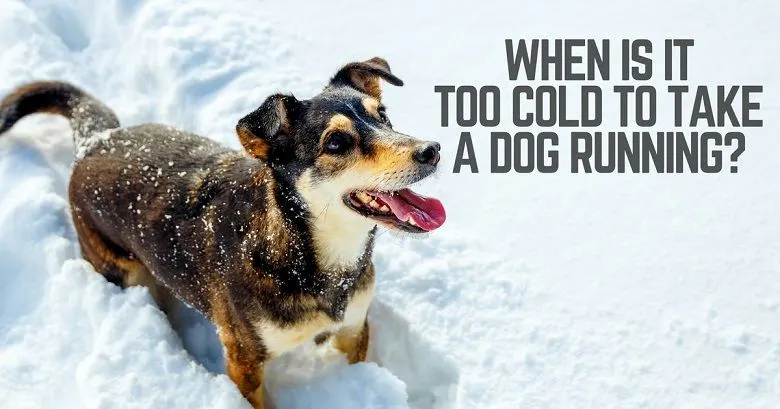
How to know if it’s too cold to run with your dog
Ask yourself these questions about winter running with your dog:
- How old is the dog? Puppies and seniors tend to get colder quicker, plus they may not be the best candidates for running anyway.
- How long are you going to be running? A half-hour should be fine in most temps unless it’s below 0.
- How much fur does this dog have? Obviously a Boston terrier is going to have a harder time than an American Eskimo dog or a husky bred for actual sled dog racing!
- How much body fat does the dog have? Lean, muscular dogs tend to start shivering sooner than dogs with more “width.”
- How much energy does the dog have? Usually when a dog is a bundle of energy, she’s going to do OK in the cold for at least short periods. Her heart rate will be up from the excitement of getting out, and her body will warm up from the workout.
- Is this dog used to the cold? Obviously a Minnesota dog will be used to the cold compared to a dog that recently moved to a cold climate.
- Does the dog need a coat? (more on that below)
- Does the dog have sensitive paws? Does he need booties?
- When in doubt, skip the run or leave the dog home.
*Enjoying this article? Get realistic dog training tips emailed once a week. Click Here
Dog running gear – winter running with dogs
One thing that also helps is to use a hands-free dog leash because it’s harder to hold a leash (and poop bags) when you’re wearing gloves or mittens!
I’m going to go over:
- Dog coats
- Dog boots
- “Musher’s Secret”
- Reflective & LED collars
Dog coats – Does my dog need a coat in the winter?
Your dog probably doesn’t need a coat while running as long as it’s 20 degrees or warmer. Of course, if you notice your dog frequently shivering or if you regularly plan to be out for more than 45 minutes, a coat might be a good idea. EVERY DOG IS DIFFERENT.
I typically did not put a coat on my black Lab mix Ace, but I do put a vest on my weimaraner these days.
We live in Montana, and my weim has such short hair and very little body fat. Plus, we regularly go on training runs that are several hours in the mountains as we train for ultra marathons. So yes, a coat is very helpful for our current dog!
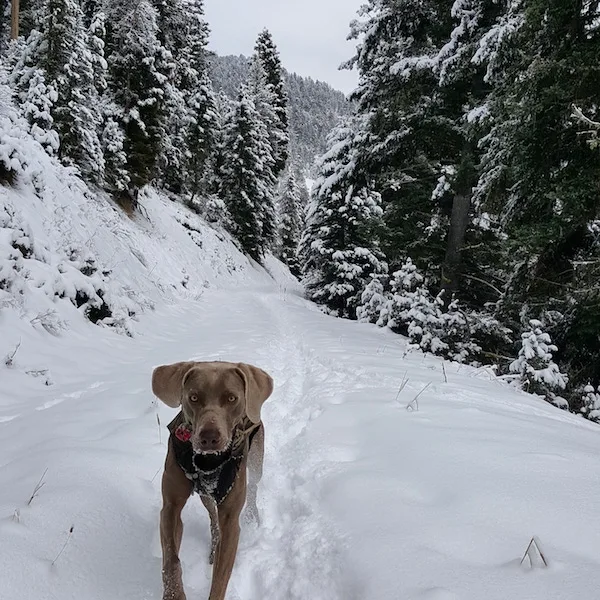
Just know that most dog sweaters and fleeces are cute as far as a fashion statement, but they don’t do a whole lot as far as warmth. I recommend Ruff Wear’s dog coats or a hunting vest. More on both options below.
*Enjoying this article? Get realistic dog training tips emailed once a week. Click Here
How to get my dog used to wearing a coat
Remember that it’s unnatural and uncomfortable for most dogs to wear a coat. A coat makes some dogs feel very submissive since the material is placed over them.
This was definitely the case with my Lab mix Ace (RIP). I knew he would much rather be cold than wear his coat. When I put his vest on him, his whole body posture changed. He cowered and held himself lower to the ground.

If you buy a coat for your dog, don’t make fun of him when he wears it. Instead, give him treats and praise and head out for a walk or something fun! Tell him what a good boy he is in his stylish jacket! All the other dogs will be jealous!
In the book Inside of a Dog, Alexandra Horowitz wrote how dogs generally don’t need to wear coats (they have their own!).
“Both dogs and wolves have, clearly, their own coats permanently affixed,” she wrote. “One coat is enough: when it rains, wolves may seek shelter, but they do not cover themselves with natural materials.”
She went on to describe how a coat presses against the back, chest and even the head of a dog, an uncomfortable feeling to them.
“There are occasions when wolves get pressed upon the back or head: it is when they are being dominated by another wolf, or scolded by an older wolf or relative.”
Of course, there are always exceptions. Some dogs love the coats we put on them. They may associate the coat with a walk or with affection from us. Others just learn to put up with it, as they put up with so many other obnoxious things from us – hugs, for example.
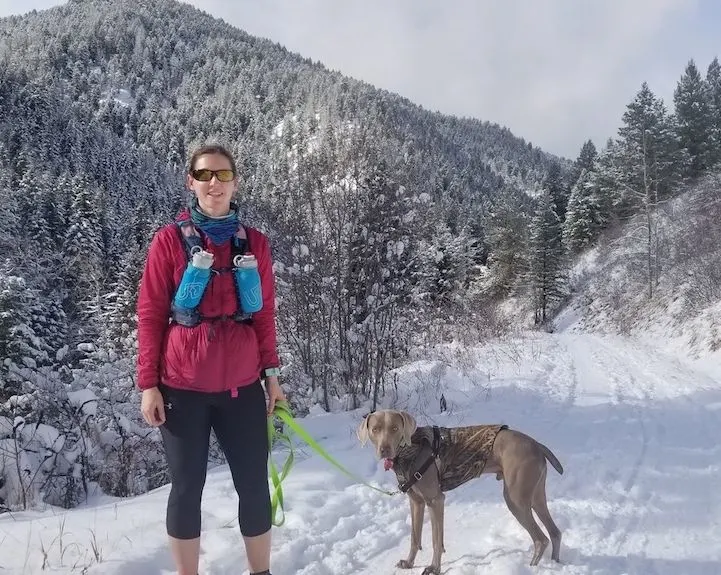
What kind of coat is best for my dog?
If you do invest in a dog coat for warmth (vs. a fashion statement), I recommend you go to a sporting goods store that carries winter gear for hunting breeds.
I bought an Avery camouflage hunting vest for my dog Ace in 2008 and now Remy wears it so it’s lasted over 12 years!!
Dog hunting vests may not be the style you’re looking for, but ours does keep Remy’s core warm when necessary. It’s made for Labs to wear while duck hunting, so it’s no joke. Remy wears it while we run in the mountains, and Ace used to wear it on our cold-weather camping trips when we were not moving around as much.
If you want something more stylish, we love the dog coats from RuffWear, and they come in different colors.
Below is a picture of Remy wearing Ruffwear’s “Powder Hound” jacket. It’s adorable and fits him well.
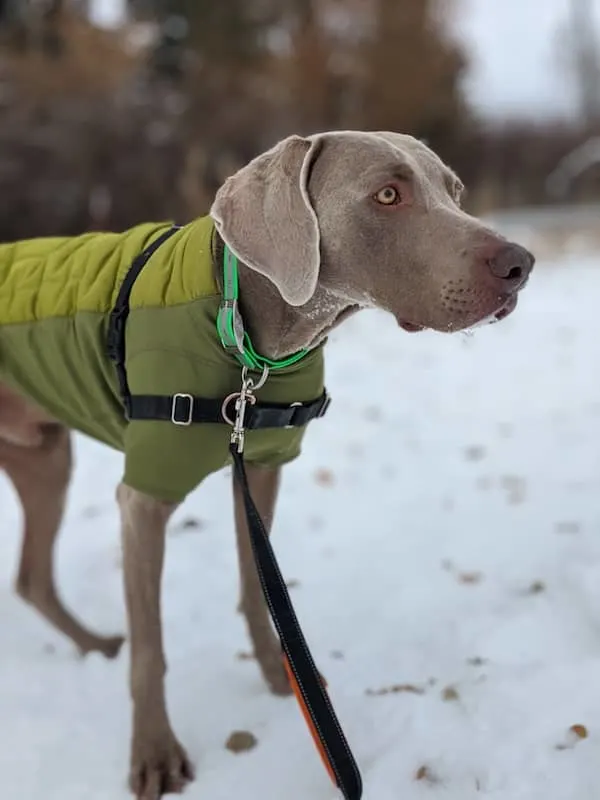
Does my dog need boots in the winter?
For winter running with dogs, your dog most likely will not need boots unless it’s below 15 degrees or if you’re going to be out for a few hours. Dogs’ feet are actually very tough and as long as you’re moving, your dog’s feet will probably be OK.
Does a dog’s feet get cold in the snow?
So much depends on the dog. My weimaraner’s paws get cold when it’s below 15 degrees or so. I bought some Muttluks dog boots for my dog and they are great quality and stay on well if you get the right size (measure!). There are a few varieties and I prefer the fleece lined Muttluks.
If your dog is holding up his paws when out in the cold, then that is an obvious sign that his feet are cold and he might also benefit from dog booties.
See my Muttluks dog boots review.
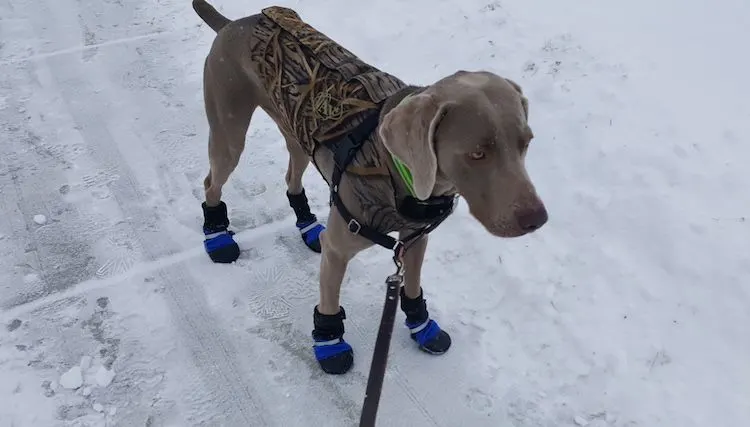
How to prevent snow and ice buildup between a dog’s toes
It’s much more common for dogs to need boots to prevent snow and ice buildup between the toes than protection from the cold. For winter running with dogs, this is very common with medium-haired and long-haired breeds. The snow sticks to their fur and can easily freeze.
The longer the dog is out, the more snow builds between their toes and this can be very painful! The snow keeps getting packed tightly until it becomes a frozen ice chunk stuck to the poor dog’s foot.
A thin pair of dog boots is enough protection to keep the snow and ice from gathering between your dog’s toes. The lighter the boots, the better. Remember, they’re not necessarily for warmth. And dogs really don’t like to have anything on their feet. See the Pawz boots below!
Pawz dog boots for winter running with dogs
I’m linking to a brand called Pawz dog boots because this is a product I’ve found very effective for some of my dog running clients.
These boots are not designed to keep a dog’s paws warm. They are designed to protect paws from chemicals and rough surfaces, and they’re pretty durable.
The boots are very thin, like a sock, but they’re made of natural rubber and are therefore waterproof. They are meant to be disposable, so the dog wears each pair maybe 5 or 6 times and then you throw them away.
You get 12 boots in a pack, so they last awhile, and each can be worn several times. They’re 100 percent biodegradable, according to the company. And they’re also great for dogs that tend to shuffle their feet and wear down their paw pads.
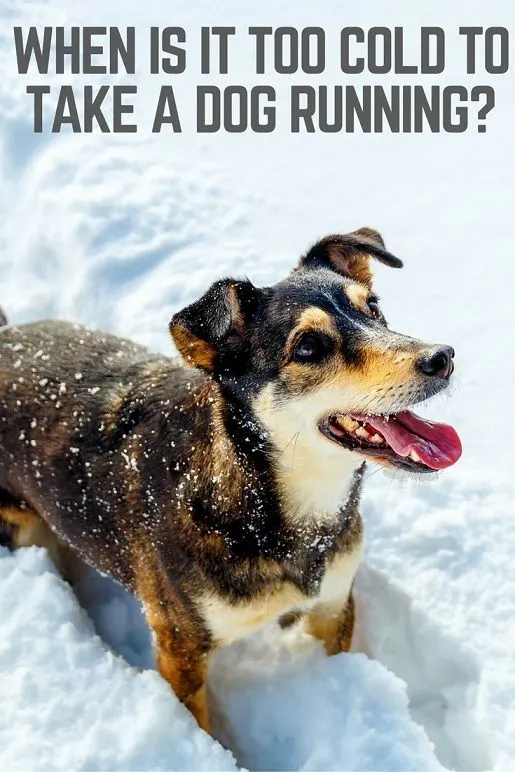
Protect a dog’s paws from chemical de-icing material
I also recommend a light pair of boots for your dog if your running route has unavoidable portions of streets or sidewalks with chemical de-icing materials or salt.
This can obviously irritate a dog’s paws, and it’s not all that great for him to be licking off his feet afterwards, either.
Again, go with the lightest pair possible. You could use the Pawz dog boots above or if you need something for warmth, too, then go with the Muttluks.
Most dogs won’t need protection against jagged or potentially sharp ice on the road, but if this is a concern for you, that might be another reason to consider a thin pair of dog boots.
Musher’s secret – winter running with dogs
Musher’s Secret is a natural wax you can rub onto your dog’s paws to protect the paws from the elements. This is a unique product because you can use it in the summer too, to protect against hot sand or sharp rocks.
I have not used Musher’s Secret for my own dogs but others have recommended it to me. It creates a barrier that also keeps snow and ice from building up on the fur between your dog’s toes.
If you’ve used Musher’s Secret, let me know if it worked for you in the comments.
Noxgear LED harness
You may want to consider using a reflective or LED harness for your dog while running in the darker winter months.
There are many options to choose from such as the Noxgear brand.
NOTE: Attach your dog’s leash to the normal harness or collar you would normally use. The Noxgear harness is NOT designed to hold up to strong pullers. Use it only for visibility.
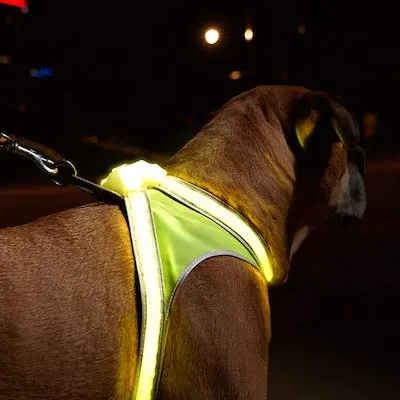
LED collars for dogs
An LED collar is also a good idea to keep you and your dog visible and safe while running in the dark hours if a harness is not your style. Again, LED collars are typically not designed for strong pullers so I recommend you use it with your regular collar or harness set up. The last thing you want is your dog to break free in the dark.
You may also want to just go with a simple LED clip on light. Add it right on your dog’s normal collar or harness.
How far should I run with a dog in the cold?
When is it too cold to run with a dog? When in doubt, skip the run or go shorter than normal.
If you’re willing to brave the cold, I recommend you keep it to 30 minutes whenever it’s around the zero-degree mark or below. If needed, you could head inside to warm up for five minutes, and then head back out to finish the run. I’ve done that plenty of times.
I’ve also kept my route closer to the house than usual. The dogs and I have done plenty of laps around a couple of blocks on cold days just so we can easily head home if needed.
Here’s a video of me running with my family’s three dogs:
I recommend you do not run for more than 30 minutes with your dog unless you really know what the dog can handle. Sure, if you’ve had the dog for years and you’ve gone running in the cold together every winter, then you know what your dog can handle.
If this is your first winter together, just stay on the safe side and ease into your winter running.
How long can dogs run in the snow?
It depends. It’s not so much the snow itself but the temperature and the condition of the snow. For example, if the snow is wet and there’s enough of it on the ground, it will clump on the fur of some dogs, building up between their toes. If your dog’s fur is short, this may be a non-issue.
Light, powdery snow will likely not be an issue itself. It would be the actual cold temperature that might bother your dog’s feet.
When in doubt, just stop and check every 10 mins or so to make sure your dog’s paws are clear of snow. Or bring a pair of dog booties in your pockets or pack, just in case.

Other tips for winter running with dogs in the cold:
- Give your dog enough water when you get home. Winter weather brings really dry air in some areas. Just because your dog is not panting doesn’t mean she’s not getting a good workout. I’m often sweating like crazy on sub-zero runs due to over-dressing! (gross, right?)
- Start out on the safe side and slowly build up your dog’s tolerance for the cold.
- Consider other exercise options such as a treadmill, dog agility or even obedience training when it’s too cold to walk the dog.
- Pay attention to your dog. Let him tell you if he’s too cold. Is he lifting his paws? Is he shivering? Does he appear concerned? Or, is he acting happy go lucky by offering play bows, giving a big “smile” and trying to eat snow?
- Heat is far more dangerous for most dogs than the cold.
- Just because it’s cold doesn’t mean you can’t exercise your dog. More often than not, the owner uses “it’s too cold” as an excuse. Try 10 minutes. I’m guessing you and your dog will be just fine.
- Invest in winter gear for yourself and your dog if it will make the two of you more likely to exercise.
- Consider dog daycare in the winter to get your dog exercise and socialization
See my post: How to exercise your dog indoors
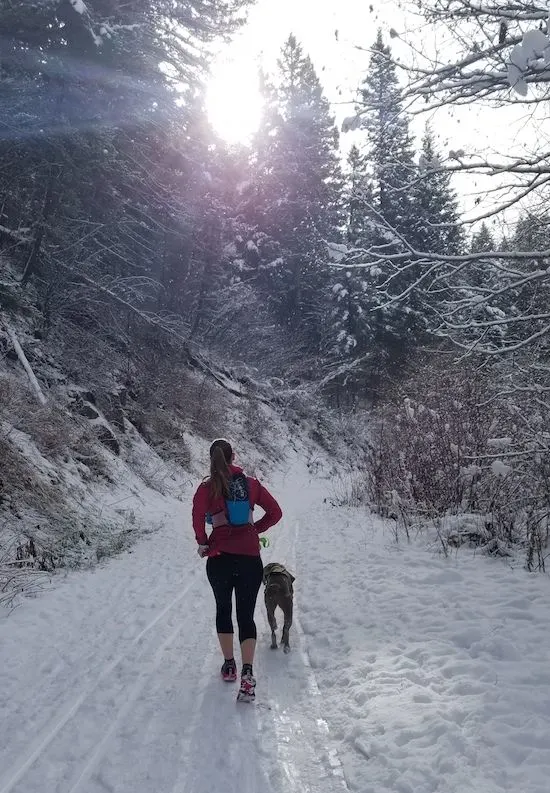
When should professional dog walkers cancel their appointments due to the cold?
When is it too cold to run with a dog? As a professional dog runner in Fargo, my idea of “too cold” was not always the same as my clients’ idea of too cold.
On crazy-cold days, I would simply touch base with each one individually and ask them what they thought was best. There is always a week or two in January where it’s just insanely cold, even for North Dakotans!
I would say something like, “I’m still planning on running with Juno today as usual, but if she gets too cold we will head inside early. Let me know what you think.”
This gives the dog’s owner the opportunity to respond either way. She might say, “OK, great. Do what you think is best.” Or she might say, “It’s too cold. Let’s skip today.”
If the owner told me to go ahead and run, I used common sense by considering everything I said earlier in this post. Every dog is different, and honestly, it’s never too cold for some dogs.
OK, runners, I want to hear from you!
How do you decide when it’s too cold for your dog?
Let me know in the comments!
*Enjoying this article? Get realistic dog training tips emailed once a week. Click Here
Related posts:
- My Dog Won’t Pee Outside When It’s Raining
- Ultra marathon training with dogs
- Best breeds for running long distance
- Training dogs for the Iditarod
FAVORITE PRODUCTS FOR WINTER RUNNING:
Lindsay Stordahl is the founder of That Mutt. She writes about dog training, dog exercise and feeding a healthy raw diet.

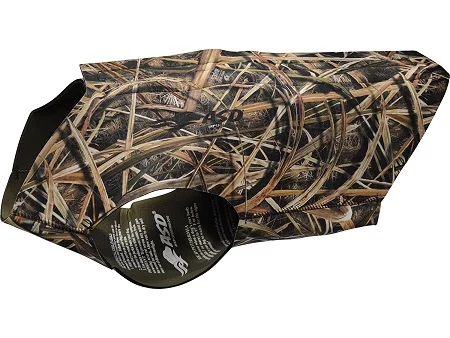
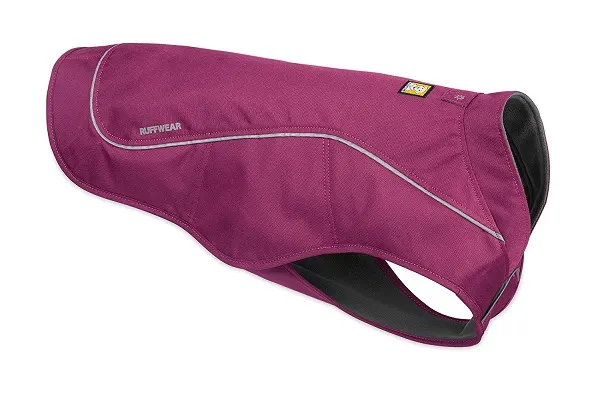
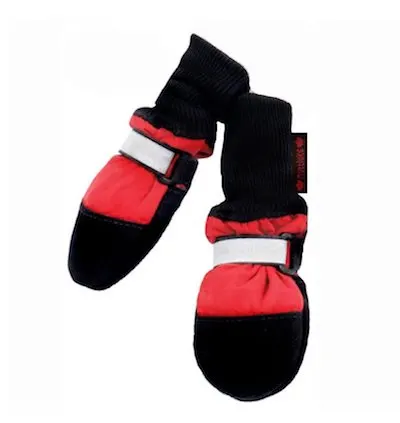
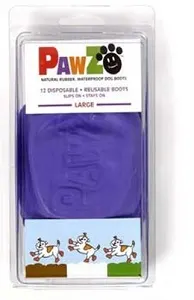
Kim Chappell
Sunday 26th of January 2020
I’ve found most double coated breeds ( ACD, Husky, Labrador) tolerate the cold well, the first thing on them that gets cold is the paws, especially if they are walking on ice. The shorted coated and smaller breeds are more likely to benefit from a coat- it should cover the chest , belly, and hindquarters- plus allow the dogs legs to move freely.
Staying hydrated is extremely important in the cold, carry a small water bottle and offer water often to the dog. A very small first aid kit is a worthwhile addition, even for shorter runs. I use “mushers secret” paw wax year round, it helps with snowballs in paws , protects against hot pavement, and keeps the pads very soft and pliable. Non toxic, natural waxes. I often hike in the woods, so I use bright orange or red for my dogs gear.
For running I would use an “x” or “y” style harness, like sled dogs wear- Never use a no pull style harness or one that goes directly across the dogs chest, as they can cause joint and muscular issues when the dog moves. If the owner needs more control of their dog while running I suggest a properly fitted training collar.
Alex
Thursday 3rd of January 2019
I took my dane/lab mix for our first winter run. We did a mile in single digits. At the time I figured she goes out to potty and is out there for 5+ minutes, so running for 10 probably can't be too harsh. I was concerned near the end as we neared home but felt her when we got inside and nothing felt cold. Her ears were cool, but actually quite warmer than they usually are after coming in from the backyard. I expected her paws to feel chilly but they were barely even cool. Not sure I'd want to push her any longer out there, but a mile was a great exercise for both of us. Quick and painless and she seemed to enjoy herself.
Lindsay Stordahl
Thursday 3rd of January 2019
Glad you enjoyed your run, it would be unlikely that she would get too cold when you're only out for 15 mins or so.
Danielle ward
Thursday 15th of November 2018
I think I get colder before my crazy pointer when it’s really cold here in Minnesota!! I make sure to keep an eye on his body language and I check his ears if they are cold it’s time to go home usually! He hates coats and boots and seems just fine without!
Paul
Tuesday 6th of January 2015
Commenting on a one-year-old post, but here goes.
Ever have any issues with your dogs' ears or nose being damaged? This is my first year venturing out in sub-zero temperatures with a dog (in MN), and that's one area I'm nervous about. My dog seems to be impervious to cold in general, but I can't imagine ears get a ton of blood flow, and the nose obviously has no insulation at all.
Oh, and one note about coats - while I agree that fur is a remarkable insulator, it's negated in part by moderate to high wind. I run around a lake, and when we get to the leeward side... hoo boy, the coat comes in handy.
Lindsay Stordahl
Tuesday 6th of January 2015
Hi Paul. I've never had any issues with a dog's ears or nose, but I've heard many vets say those parts of the dog are the most at risk for frostbite, more so than paws. I guess all you can do is use your best judgement.
I would run with some dogs (Labs, huskies, pitbulls, etc.) for a half-hour or so no matter how cold it got (-18 F or so was probably the worst), and they were always OK. We were running, not walking, so I think that makes a slight difference. I definitely wouldn't want to be out longer than that on some of those brutally cold days.
Marilyn
Tuesday 7th of January 2014
Thanks for your informative article. It gave more practical advice and specifics than anything I've found so far -even the vet sites. Most just say don't go out when it is cold. I wanted to take my lab/coonhound (with long ears and short coat) out for a 2 hour hike tonight at 0 degree F. My vet friends said it is a bad idea because of the frostbite risk. She's a tough active girl and I think something like 15-30 minutes might be OK but decided against the longer hike.
Lindsay Stordahl
Tuesday 7th of January 2014
Yep, that sounds reasonable to me. You know your dog best. Glad I could help.